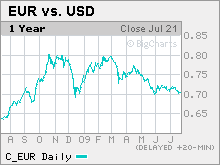Dollar falls near 7-week low
The greenback weakens against rival currencies as investors seek higher returns in other markets.
LONDON (Reuters) -- The dollar slipped on Thursday, edging close to a seven-week low against the euro and a basket of currencies as slight gains in European shares suggested risk appetite was holding up after a mixed bag of corporate earnings.
European shares rose 0.2% in early trade, heading for a ninth straight daily rise, but analysts said significant risk-related gains in currencies including the euro and sterling may be limited by lingering concerns about the weakness of the global economy.
"Recent earnings data are helping risk appetite, but nevertheless, the upsides of risky currencies are capped as the market realizes that improvements in the global economy will be slow," said Ulrich Leuchtmann, currency strategist at Commerzbank in Frankfurt.
The euro inched up 0.3% to $1.4230, climbing near $1.4278 touched earlier in the week, its highest since early June.
The pair traded in a narrow $1.4200-1.4266 range, around where options were seen expiring later in the day. IFR reported that 200 million euros with a $1.4245 strike price would expire at the New York cut, along with 300 million euros at $1.4250.
Slight euro gains helped to keep the dollar index under downward pressure. It was little changed at 78.749, but hovered near a seven-week low of 78.563 hit the previous day.
Sterling and the Australian and New Zealand dollars -- currencies often seen as being higher risk -- each rose around 0.4% against the dollar, while gaining more than 1% against a broadly weaker yen.
The dollar rose 0.7% to 94.28 yen, as the yen fell broadly on speculation that investors may flock to "toshin" Japanese investment trusts launching this week which will invest in overseas assets and foreign currencies.
The Swedish crown rose to a three-week high versus the euro , brushing off a rise in the Swedish jobless rate to 9.8% in June as the data was lower than expectations and held below the psychologically vital 10%.
Investors awaited more second-quarter earnings from U.S. and European firms, including American Express (AXP, Fortune 500), as well as data on U.S. jobless claims and existing home sales.
Risk appetite has been improving due to strong quarterly results from some large banks including Goldman Sachs (GS, Fortune 500), although results from Morgan Stanley (MS, Fortune 500) on Wednesday were disappointing.
The intraday correlation between the dollar and equities at times has been erratic during the current earnings season, but analysts at JPMorgan (JPM, Fortune 500) said the general move lower in the dollar this month has been a solid response to "extraordinarily high" upside earnings surprises, which have stoked risk demand.
"The day-to-day price action may suggest some breakdown in the expected negative USD/equity correlation, but the dollar's decline this month has been in line with its usual sensitivity to earnings surprises," they said in a research note.
Markets offered little reaction to Federal Reserve Chairman Ben Bernanke, who on Wednesday reiterated that the U.S. economic outlook was improving but supportive policies would be necessary for a while. ![]()


